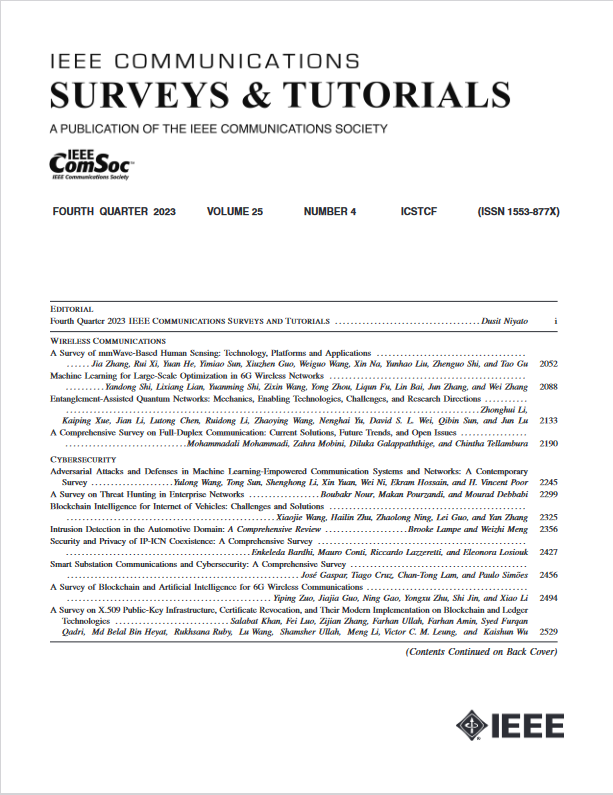A Survey on Over-the-Air Computation
IF 34.4
1区 计算机科学
Q1 COMPUTER SCIENCE, INFORMATION SYSTEMS
引用次数: 16
Abstract
Communication and computation are often viewed as separate tasks. This approach is very effective from the perspective of engineering as isolated optimizations can be performed. However, for many computation-oriented applications, the main interest is a function of the local information at the devices, rather than the local information itself. In such scenarios, information theoretical results show that harnessing the interference in a multiple access channel for computation, i.e., over-the-air computation (OAC), can provide a significantly higher achievable computation rate than separating communication and computation tasks. Moreover, the gap between OAC and separation in terms of computation rate increases with more participating nodes. Given this motivation, in this study, we provide a comprehensive survey on practical OAC methods. After outlining fundamentals related to OAC, we discuss the available OAC schemes with their pros and cons. We provide an overview of the enabling mechanisms for achieving reliable computation in the wireless channel. Finally, we summarize the potential applications of OAC and point out some future directions.无线计算研究综述
通信和计算通常被看作是独立的任务。从工程的角度来看,这种方法非常有效,因为可以执行孤立的优化。然而,对于许多面向计算的应用程序,主要关注的是设备上本地信息的功能,而不是本地信息本身。在这种情况下,信息理论结果表明,利用多址信道中的干扰进行计算,即空中计算(OAC),可以提供比分离通信和计算任务更高的可实现计算率。而且,随着参与节点的增加,OAC与分离在计算率上的差距也会增大。鉴于这一动机,在本研究中,我们对实用的OAC方法进行了全面的调查。在概述了与OAC相关的基础知识之后,我们讨论了可用的OAC方案及其优缺点。我们概述了在无线信道中实现可靠计算的启用机制。最后,总结了OAC的应用前景,并指出了未来的发展方向。
本文章由计算机程序翻译,如有差异,请以英文原文为准。
求助全文
约1分钟内获得全文
求助全文
来源期刊

IEEE Communications Surveys and Tutorials
COMPUTER SCIENCE, INFORMATION SYSTEMS-TELECOMMUNICATIONS
CiteScore
80.20
自引率
2.50%
发文量
84
审稿时长
6 months
期刊介绍:
IEEE Communications Surveys & Tutorials is an online journal published by the IEEE Communications Society for tutorials and surveys covering all aspects of the communications field. Telecommunications technology is progressing at a rapid pace, and the IEEE Communications Society is committed to providing researchers and other professionals the information and tools to stay abreast. IEEE Communications Surveys and Tutorials focuses on integrating and adding understanding to the existing literature on communications, putting results in context. Whether searching for in-depth information about a familiar area or an introduction into a new area, IEEE Communications Surveys & Tutorials aims to be the premier source of peer-reviewed, comprehensive tutorials and surveys, and pointers to further sources. IEEE Communications Surveys & Tutorials publishes only articles exclusively written for IEEE Communications Surveys & Tutorials and go through a rigorous review process before their publication in the quarterly issues.
A tutorial article in the IEEE Communications Surveys & Tutorials should be designed to help the reader to become familiar with and learn something specific about a chosen topic. In contrast, the term survey, as applied here, is defined to mean a survey of the literature. A survey article in IEEE Communications Surveys & Tutorials should provide a comprehensive review of developments in a selected area, covering its development from its inception to its current state and beyond, and illustrating its development through liberal citations from the literature. Both tutorials and surveys should be tutorial in nature and should be written in a style comprehensible to readers outside the specialty of the article.
 求助内容:
求助内容: 应助结果提醒方式:
应助结果提醒方式:


